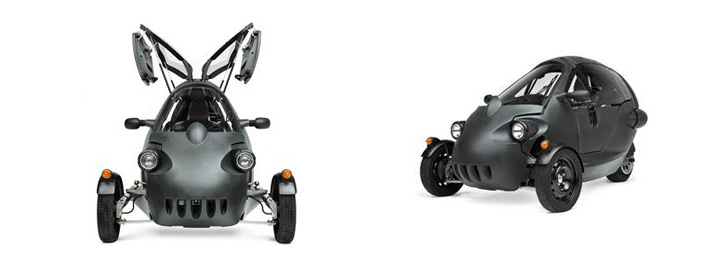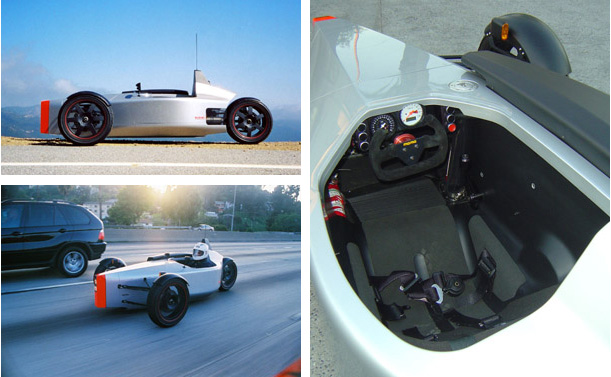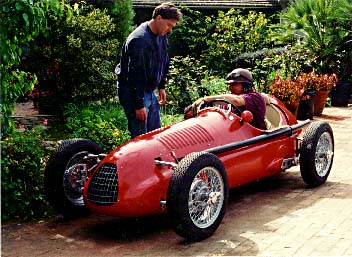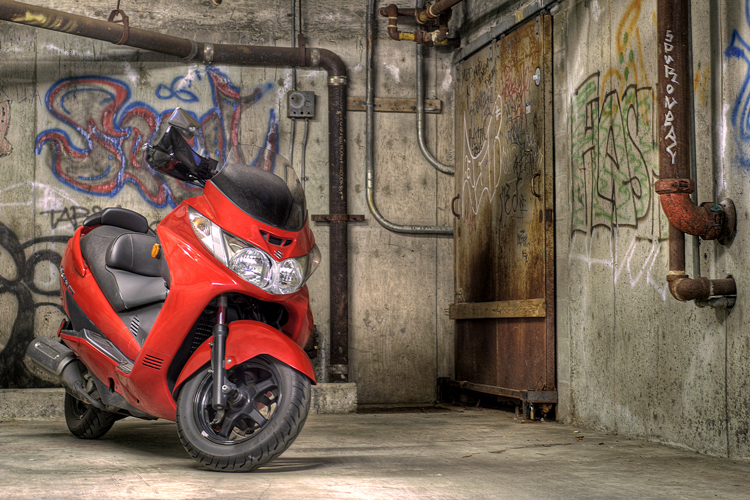The Cree SAM

Via Diseno-art.com:
The Cree SAM is a product of Swiss company Cree Ltd. The SAM is an environmentally friendly zero emissions vehicle powered by an electric motor. Only 80 Cree SAM’s have been produced so far, and most were bought by private consumers for public testing in Switzerland.
The electric motor of the Cree SAM is capable of propelling the 3-wheeler up to 53 mph (85 km/h). And on a full charge the SAM has a range of 30 – 45 miles (50 -70 kilometers).
The lightweight Cree SAM is built on an extruded aluminum chassis, and the two occupants, seated in tandem, are protected by the air-filled, double wall, thermoplastic body.
The SUB G1

Also via Diseno-art.com:
The SUB G1 is a 3 wheeled sports vehicle which was first unveiled in April 2005. SUB is a small company based in Southern California run by three design professionals with impressive resumes, and between them the skills to design, model, engineer, and construct, high quality production machines like the SUB G1.
The G1 is a development of a similar concept vehicle (the 1up) created by one of the group, Niki Smart, years earlier. Smart, along with Jay Brett, an industrial designer with experience in constructing concept vehicles for films, and Nick Mynott, a digital modeller with experience in race and concept car construction, decided to develop an attractive, single seat, high performance sports vehicle, specifically designed for entertaining handling and extreme fun.
So far, three SUB G1’s have been built and handed over to their owners, 2 in the US and one in the UK, and each has covered over 1000 miles, with no problems.
One of the most noticeable features of the G1 is the outstanding build quality and level of professionalism visible in the overall design. Each part, down to the nuts and bolts, has been well thought out and made to fit with the finished product. By using computer models, the team was able to digitally create and adjust components before manufacturing, therefore reducing costs and unforeseen construction problems.
Power for the SUB G1 comes from a 1000cc Suzuki V-Twin taken from the Suzuki TL1000R sportsbike. The group had originally envisaged an inline 4 cylinder taken from the Yamaha R1, however early on in the mockup stages the group realised they would run into some packaging issues which would upset the 50/50 weight distribution, and the layout they wanted. The Suzuki V-twin fits perfectly, and is mounted to the right of the driver in its own compartment. Developing 135 horsepower and 105 Nm of torque, the engine is force-fed by the noticeable snorkel sitting above the bodywork. Transmission is handled by a 6 speed sequential gearbox connected to the rear wheel by a chain. Current prototypes have no reverse at the moment. But then again, if you’re to lazy to get out and push the diminutive G1 a couple yards it’s probably not your type of vehicle. The instrument gauges also come from Suzuki, and the cutoff sports steering wheel can be removed to ease entry and exit – while also providing a simple security device, if you take it with you.



